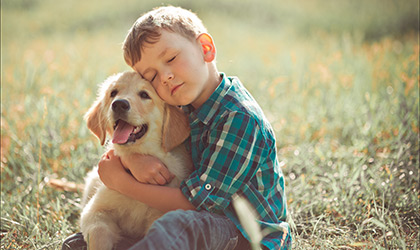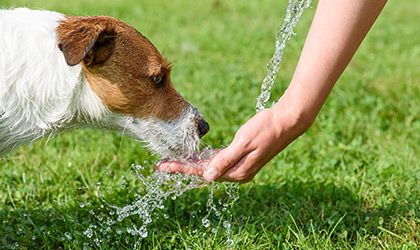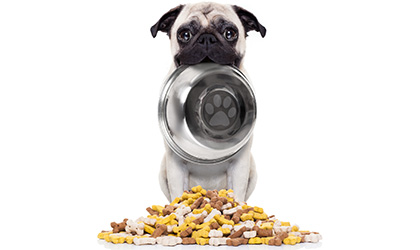
Dogs display personality traits in the same way us humans do. And it’s these unique quirks and peculiarities that compel us to gush and coo over them. Perhaps your pooch hogs the TV, relishes getting dressed up, or showers you with gifts (a.k.a. slippers, toys and blankets) when you return home from work. Whatever their special ‘thing’, our beloved companions are as weird and wonderful as the next, and that’s precisely why we love them. But our furry friends aren’t always beaming with cuteness and cuddles; they can commit all sorts of naughtiness too. Since we aren’t fluent in canine-tongue, this disobedient behaviour isn’t always easy to get to the bottom of. However, as their owner and chief safe guarder, it’s well worth learning how to interpret these behavioural tendencies because they can reveal deeper things about your dog’s emotional and physical wellbeing. Once you start understanding what triggers their mischievousness, you can begin exploring ways to alleviate it.
Aggression
Aggression is a bit of an umbrella term in the canine world. It encompasses a multitude of behaviours and can mean a host of things. An aggressive dog may exhibit some of the following tendencies.
-
Becoming very still and stiff
-
Barking that sounds guttural and threatening
-
Charging at someone with no contact
-
Muzzle punching (punching someone with his/her nose)
-
Growling
-
Snarling (growling and showing teeth)
-
Snapping
-
Nipping that doesn’t mark the skin
-
Biting that pierces the skin
-
Biting that bruises the skin
-
Biting repeatedly in rapid succession
-
Biting and shaking
By analysing the context of your dog’s disobedience and aggressiveness, you can begin to understand what triggers their behaviour.
-
Predatory aggression: certain dogs display archetypal predatory tendencies, including chasing and snatching fast-moving things
-
Sex-related aggression: some male dogs will contend for the attention of females in heat, while females may also vie for access to a male
-
Pain-elicited aggression: an otherwise friendly dog may be prompted to behave aggressively when in pain or ill
-
Frustration-elicited aggression: a dog that’s aroused by something but held back from approaching it may become aggressive
-
Social aggression: a dog that perceives itself as ‘pack leader’ may show aggression towards family members
-
Defensive aggression: defensively aggressive dogs are primarily motivated by fear, and often decide that defence is the best offence
-
Fear aggression: if trapped or cornered, a fearful dog may become aggressive
-
Possessive aggression: many dogs showcase aggressiveness over their possessions, such as food, a toy or their bed
-
Territorial aggression: some dogs may attack an intruder, regardless of whether they’re friend or foe
But what exactly makes a dog aggressive?
Poorly socialised puppies turn into aggressive, anxious adults
Pups have a ‘golden window’ of impressionability, from about 3 weeks to 3 months of age. During this period, they’re malleable enough to form relationships with people and other animals, and understand that certain experiences, sights and sounds aren’t to be dreaded. They also learn how to use vocalisation, body language and interact with those around them. Puppies that aren’t adequately socialised during this timeframe will grow into adulthood terrified of other dogs and people, and react badly to environments, sounds and objects. This fear and anxiety can then manifest into aggressiveness.
Testosterone incites aggression
As with humans, hormones have a considerable effect on a dog’s behaviour. Testosterone can make male dogs more territorial, more dominant and more eager to engage in conflict with other furry-foes. In most cases, getting your male dog neutered will increase your chances of having a calm, peace-loving pooch.
Dogs lacking boundaries are more likely to be aggressive
Are you guilty of never getting your dog to do anything it doesn’t want to do? You may think you’re being a doting owner, but this ‘kindness’ isn’t doing your four-legged friend any favours. By lapsing on boundaries, your dog can do what it wants, when it wants to. Essentially, it gives it a green card to to behave without answering to any restrictions, so when a necessary boundary is imposed (e.g. visiting the vet), the dog will react with aggression. Bottom line: your pooch needs to get on board with your house rules. And you need to be strict about enforcing them. No excuses.
Lack of exercise triggers frustration in dogs, causing them to behave badly
Your average dog needs to be exercised for at least half an hour, twice per day. Simply letting them out the back door isn’t good enough. You need to expose your pooch to different environments, other dogs, and allow them to freedom to roam off the lead. Insufficient exercise will lead to frustration, boredom and bad behaviour.
Useful tips
-
Be a calm and decisive owner – remember, your dog can sense tension and fear
-
Teach avoidance. For instance, when you see another dog, keep your eyes forward and continue to walk at a natural pace. This way, your pooch will understand that when you see other dogs, you avoid rather than confront.
-
Interrupt bad behaviour – your dog’s aggression will worsen if you don’t stop it.
-
Reinforcement and reassurance. Give your pooch a treat every time it deals with a new situation, dog or person.
-
Choose natural, chemical-free foods (additives will just add fuel to the fire!)
-
Essential oils have been found to help fractious animals. Apply a couple of drops on a bandana and tie it around your pooch’s neck – lavender often does the trick.
-
Exercise your dog regularly – ensure they are too exhausted to be aggressive
-
If you’re truly at your wits end, it’s worth consulting a dog behaviour specialist
Separation Anxiety
Have you ever left your pooch alone only to return to sheer and utter chaos (hyperbole intended)? Your furry-friend (or foe by this point) has urinated, defecated, chowed down every last morsel of food, and torn up book, newspaper and magazine alike. Oh, and that’s not forgetting the furious note you received from your neighbour complaining about the incessant barking and howling. Sound familiar? While these problems may signal your dog needs to brush up on its house manners, they can also exhibit separation anxiety. Such anxiety is triggered when a dog becomes agitated due to separation from its owners. If your dog commits any of the following crimes when alone, this raises a red flag and it’s possible they have separation anxiety.
-
Urinating and defecating
-
Coprophagia (consuming their excrement)
-
Barking, howling or whining
-
Chewing, digging and destruction
-
Escaping
-
Pacing
The reasoning behind this mental phenomenon in dogs is a little fuzzy and inconclusive. However, the following situations may trigger this behaviour.
-
Change of family or guardian – being surrendered to a shelter, abandoned, or given to a new family
-
Change in schedule – a sudden change in how long the dog is left alone for
-
Change in residence – moving house or travelling
-
Change in household members – the absence in a household member, either due to moving away or death
Useful tips
-
Start by leaving your dog alone for five minutes, then extend it to twenty minutes, and then an hour
-
Before you leave for the day, make sure you take your dog for a walk
-
Don’t make a big fuss when you leave or return; this way your pooch will think it’s just business as usual
-
Leave your dog with the comfort of an audio book or radio programme
Destructive chewing
Chewing objects is a natural way for puppies and dogs to explore the world around them. For young pups, chewing can relieve teething; and for older dogs, it’s nature’s way of keeping teeth clean and jaws strong. Destructive chewing, however, can often result from the following psychological distress.
-
Boredom
-
Lack of mental stimulation
-
Stress and frustration
-
Insufficient exercise
-
Separation anxiety
-
Hunger
Useful tips
-
‘Dog-proof’ your home. Keep clothing and shoes in a wardrobe; keep dirty laundry in the basket (pooches can be notorious knickers fiends!); and keep books on shelves.
-
Provide your dog with plenty of its own toys and edible chews like rawhide bones or pig ears.
-
Ensure you walk your dog regularly, offering it plenty of mental stimulation.
Take home message
As your dog’s ‘pack leader’, you need to establish rules, boundaries and limitations to instil obedience. Consistency from you and everyone in your household will bolster your pooch’s confidence and help stamp out bad behaviour. Remember, your four-legged friend is a highly intelligent, highly sensitive, and highly receptive creature – offer it a healthy, loving and nurturing living environment, and it will thrive.
References:
-
ASPCA. 2018 Common dog behaviour issues. Avaliable online: https://www.aspca.org/pet-care/dog-care/common-dog-behavior-issues
-
J RSPCA. 2018 Canine aggression. Avaliable online: https://www.rspca.org.uk/adviceandwelfare/pets/dogs/behaviour/aggression
-
J Dogs Trust. 2010 Dog behaviour problems. Avaliable online: https://www.dogstrust.ie/help-advice/factsheets-downloads/behaviourproblems.pdf



